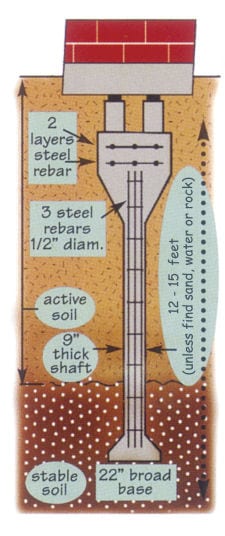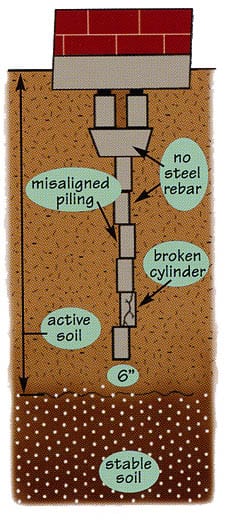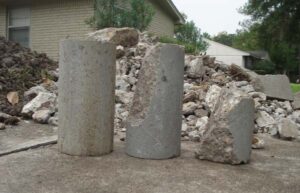Most homeowners are NOT aware of the quality differences of common home foundation repair methods that are available in Fort Bend County and throughout Texas. The most common repair method used by almost all foundation contractors is the “Pushed Piles” method. There are various versions of the this method but all of them are low quality repair methods.
Bell Bottom Piers

The Bell Bottom Pier repair method is the Highest Quality Foundation Repair method available in Fort Bend county. It has multiple advantages when compared to other repair methods. Some of these advantages are:
- Permanent
- Proven and Time-Tested (100 years)
- Stronger – Monolithic (single piece construction)
- Excavation Can be Inspected prior to Concrete Pour
- Large Footprint for Stability
- Bell Bottoms Resist Uplift
- Entire Pier Provides Support and Resists Settlement
- Factor of Safety (can support 5-10 times the necessary weight)
Bell Bottom Piers are constructed the “old-fashioned” way – very similar to the way structural concrete columns are built for highways and bridges. A hole is excavated and then filled with concrete and steel rebar. In addition, for a Bell Bottom Pier a belling tool is used to enlarge the base of the column so that it will provide additional stability and support many times the necessary weight.
Pushed Piles

The Pushed Piles method is quick, has low material costs, and is very profitable for the foundation contractor. In addition, this method has multiple limitations and disadvantages as a foundation repair method. This method of foundation repair has been labeled “temporary” and “useless” by the structural engineers at A-1 Engineering in San Antonio and Austin. It is an opinion based on known facts. This is the lowest quality method of foundation repair utilized in Texas but it is the most common because it is the most profitable for the foundation repair contractors. Pressed piles are concrete cylinders that are pressed into the ground under a home’s foundation. The hope is that the hydraulic system will drive the piles vertically into the ground. This can only be hope since there is no method to confirm the fact. If the concrete cylinders hit a rock, tree root, or crack during driving they can skew off on an angle and then they will offer little or no support for a concrete slab foundation. Although some more recent versions of this method have attempted to “tie” the concrete cylinders together with a cable or steel rods, it is a poor substitute for a single unit support structure. The 12 inch concrete cylinders will be individually pressured by the forces of soil movement. In addition, since the house itself is being used as the weight to drive the concrete piles into the ground, the foundation can be significantly damaged by crew error.
See one major disadvantage in the photo below.
Two of these pushed piles broke during the first step of the hydraulic installation. One of the significant disadvantages of this repair method is that there is NO ABILITY to verify that the column of pushed piles is vertical or if any of the underground piles have been crushed or severely damaged.
What Independent Structural Engineers Think Of Pushed Piles
The independent structural engineers at A-1 Engineering have described this method as “one of the most useless and ineffective types of foundation repairs or foundation stabilization that you can get.” And in the image below they say this repair system will “almost always be temporary”.
Conclusion: Don’t use Concrete Press Piles Foundation Repair – this is the link to the conclusion on A-1 Engineering’s website
In addition, foundation contractors that use the Pushed Piles method do not have confidence in their work and their contracts prohibit customers from suing them for shoddy work or failed foundation repairs. Their customers must forfeit their right to sue and must use Mandatory Arbitration in a dispute. Mandatory Arbitration is very heavily weighted in favor of the business and the consumer has no right of appeal and limited due process. Businesses win Mandatory Arbitration cases more than 90% of the time. That means the consumer loses more than 9 times out of 10. Does that sound like a fair deal to you?
Have Questions? Then visit the Frequently Asked Questions page for answers to the most commonly asked questions. Or call (281) 912-0508 for immediate service.
Request An Estimate: Schedule Your Free Home Foundation Inspection Today.

